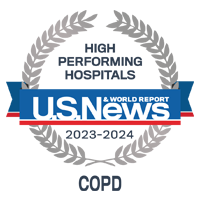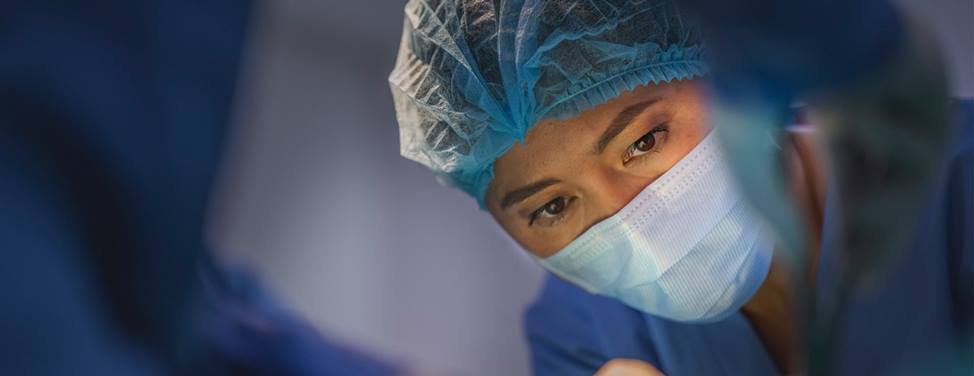Bronchiectasis

Overview
Bronchiectasis is a type of chronic obstructive pulmonary disease (COPD) in which mucus accumulates and sticks in the airways of the lungs, called bronchi. As a result, the airways become infected and inflamed, eventually leading to enlarged and weak airways, which allows more mucus and bacteria to accumulate.
Bronchiectasis most often affects children, although people of all ages are diagnosed with the condition. It can be caused by lung injury from other conditions, including cystic fibrosis, tuberculosis, pneumonia and immunodeficiency disorders, such as HIV and AIDS.
Our approach to bronchiectasis
UCSF offers comprehensive evaluations and care for all types of COPD. When treating bronchiectasis, we aim to address underlying conditions, clear mucus from the lungs and prevent complications. Treatments may include medications, physical therapy or devices that help open and clear the airways, and antibiotics to fight any respiratory infection.
Lung surgery or transplantation may be an option for patients with severe cases. UCSF is currently the top lung transplant program in the U.S. for higher-than-expected patient survival rates and graft survival rates (ongoing function of the transplanted lungs).
In addition to caring for patients, we lead research to improve the understanding and treatment of COPD. Interested patients may have the option to receive experimental treatments by participating in a clinical trial.
Awards & recognition
-

Among the top hospitals in the nation
-

No. 8 in the nation for pulmonology & lung surgery
-

Rated high-performing hospital for COPD
Signs & symptoms
Symptoms of bronchiectasis vary for each person and in rare cases, a patient may not experience any symptoms at all. However, common symptoms may include:
- Cough, which worsens when lying down
- Shortness of breath
- Abnormal chest sounds
- Weakness
- Weight loss
- Fatigue
- Discolored or foul smelling mucus, or mucus that contains blood
Diagnosis
In making a diagnosis of bronchiectasis, your doctor will first start by conducting a thorough physical examination, recording your medical history and asking about any symptoms you are experiencing.
The following tests may then be conducted to make a definite diagnosis:
- Pulmonary function testing (PFT). This test involves a series of breathing maneuvers that measure the airflow and volume of air in your lungs. This allows your doctor to objectively assess the function of your lungs.
- High resolution computed tomography (HRCT). This is a special type of CT scan that provides your doctor with high-resolution images of your lungs. Having a HRCT is no different than having a regular CT scan; they both are performed on an open-air table and take only a few minutes.
- Chest X-Ray. Chest X-rays can help confirm a diagnosis of bronchiectasis and rule out other lung conditions.
- Sputum examination. Analysis of cells in your sputum (mucus and other matter brought up from the lungs, bronchi and trachea) can help determine the cause of some lung problems.
Treatments
The goal of treatment for bronchiectasis is to treat any underlying conditions causing lung injury, help remove mucus from the lungs and prevent further complications.
Treatment may include:
- Bronchodilator medications. Inhaled as aerosol sprays or taken orally, bronchodilator medications may help to relieve symptoms of bronchiectasis by relaxing and opening the air passages in the lungs.
- Steroids. Inhaled as an aerosol spray, steroids can help relieve symptoms of bronchiectasis. Over time, however, inhaled steroids can cause side effects, such as weakened bones, high blood pressure, diabetes and cataracts. It is important to discuss these side effects with your doctor before using steroids.
- Antibiotics. Antibiotics may be used to help fight respiratory infections caused by bronchiectasis.
- Mucus thinners and expectorants. Mucus thinners and expectorants help loosen and clear mucus from lungs.
- Respiratory therapy. People with bronchiectasis must clear mucus from their lungs on a daily basis. This may be done with chest physical therapy, which involves vigorously clapping the back and chest to dislodge mucus from the lungs. Airway clearance can also be achieved with mechanical devices that stimulate mucus clearance.
- Surgery. Lung volume reduction surgery, during which small wedges of damaged lung tissue are removed, may be recommended for some patients with severe cases of bronchiectasis.
- Lung transplant. In very severe cases, lung transplantation may be an option for some patients.
UCSF Health medical specialists have reviewed this information. It is for educational purposes only and is not intended to replace the advice of your doctor or other health care provider. We encourage you to discuss any questions or concerns you may have with your provider.










